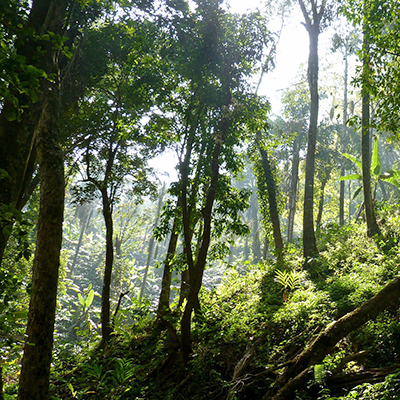Background
Forests – perhaps more than any other natural resource – support global sustainable development objectives. Forests currently store ca. 861 Gigatons of carbon, 55% more than all anthropogenic carbon emissions since the industrial revolution, and they cycle 15 times more carbon annually than humans emit. Forests are also home to 80% of terrestrial biodiversity. Forests are thus a key focus of global climate policy (SDG 13) and preservation of life on land (SDG 15). Additionally, forests contribute to the livelihoods of an estimated 1 billion rural poor through food, fuelwood, fodder, and inputs to cottage industries, and are thus vital to eradicating extreme poverty (SDG 1) and extreme hunger (SDG2).
The impact of the pandemic
The role of forests as a social safety net suggests that they were likely to play an outsized role in helping households confront the challenges of COVID-19. As a result of the pandemic, more than 400 million people globally were expected to lose their jobs, with an estimated 160 million people falling below the poverty line by 2030. The UN projected that this crisis would disproportionately affect the rural poor and particularly forest-based indigenous populations. While the impacts of COVID-19 on the world’s poor had been at the center of policy discussions, there had been comparatively less attention to the pandemic’s impacts on natural resource use. However, the Covid-19 pandemic was likely to have major, heretofore unexplored effects on forest use and management, with direct implications for both human welfare and environmental objectives over the longer-term.
Three key trends
Three key trends following COVID-19 shock were reshaping forest use in rural regions in many low income countries. First, strict lockdowns and economic contraction had led to widespread “reverse” migration from urban to rural areas, a trend that was likely to temporarily increase population and hence intensify resource use in many rural regions. Second, return migration was taking place simultaneously with a sharp decline in non-farm income opportunities locally, increasing the need for forest-based subsistence activities, particularly for the poor. Third, although rural growth patterns had led to a decline in subsistence activities in many countries in the recent years, the experience of radical uncertainty in the COVID-19 crisis may lead to a reinvestment in farm-based production activities over the medium- to long-term, potentially driving additional forest clearing for agriculture while also increasing farm households’ dependence on ecosystem services. Despite emerging evidence from scholars and practitioners working on natural resource governance issues, the magnitude of these trends and their effects on human welfare and other environmental objectives were not yet well understood.
The project
The situation offered an unprecedented opportunity to study the role of forests in helping rural communities cope with extreme livelihood challenges, and to identify policy strategies that can help to advance longer-term resilience in human-environment landscapes. Our study focused on India, a country with a very large and diverse rural population with a high degree of forest dependence, a long history of policy for community-based forest management, and considerable nation-wide variation from which to draw comparative insights.
Through mixed-methods research combining qualitative enquiry, quantitative modeling, and remote sensing analysis, the research collected primary data in forest-adjacent communities in the Indian states of Madhya Pradesh, Himachal Pradesh, and Assam. We had three primary objectives:
1) To identify and document the role and extent of forest resource use to support rural livelihoods during the COVID-19 pandemic in the three project sites.
2) To determine the impact of increased forest use during 2020-2021 on forest cover and structure.
3) To identify key past and current policies implemented by local government for forest resource management, especially those which enable sustainable coping strategies during the COVID-19 crisis.
Expected societal values
The project produced robust scientific evidence that can guide policy efforts to advance basic rural livelihood security alongside other sustainable development goals – both to address the negative effects of COVID-19 as well as to pave the way for more secure, sustainable, and resilient human-environmental systems over the long-term.
While the knowledge gained from this research generated evidence to help respond to effects of rural livelihood shocks following COVID-19, it also laid the groundwork for a larger research program.
The data collected provided a model for studying the role for forests in responses to an acute shock, which in turn underpinned a future research program on forest livelihoods and sustainable forest use in the context of a variety of future disruptions including climate change and other stressors.

